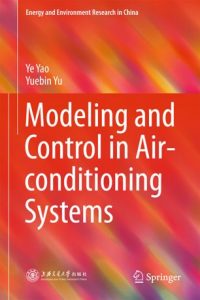Modeling and Control in Air-conditioning Systems
Modeling and Control in Air-conditioning Systems
Modeling and Control in Air-conditioning Systems mainly concerns about modeling and control in air-conditioning systems. Some advanced modeling methods including state-space method, graph-theory method, and structure-matrix method, as well as combined forecasting method, are employed for the modeling of air-conditioning systems. The virtual sensor calibration and virtual sensing methods (which will be very useful for the real system control) are illustrated together with the case study. The model-based predictive control and the state-space feedback for a better local control, and the air-side synergic control scheme and the global optimization strategy with the decomposition-coordination method are developed aiming at energy conservation of the entire system. Lastly, control strategies for VAV systems including the total air volume control and the trim-and-response static pressure control investigated with practice.
you can also read Energy Systems Modeling Principles and Applications 2019
Modeling and Control in Air-conditioning Systems content
- prefences
- acknowldgment
- about author
- content
- Introduction
![Modeling and Control in Air-conditioning Systems]()
- Component Modeling with State-Space Method
- Dynamic Simulations with State-Space Models
- Graph-Theory Modeling and Structure-Matrix Analysis
- Virtual Measurement Modeling
- Control Design Based on State-Space Model
- Combined Forecasting Models for Air-Conditioning Load Prediction
- Energy Analysis Model for HVAC System
- Optimal Control of HVAC System Aiming at Energy Conservation
- Modeling and Control Strategies for VAV Systems
- index
With the development of economy and growth of people’s living standards, air-conditioning systems are increasingly popular for the improvement of thermal environment indoors, which results in ever-increasing energy consumption of buildings. The need for rational energy use is a global concern, and challenges are energy consumption reduction without losing efficiency and quality of life. According to the US Energy Information Administration (EIA) [1] and the US Department of Energy [2], the consumption of electrical energy by HVAC (heating, ventilation and air-conditioning) systems in the residential, commercial, and industrial sectors corresponds to 18.62, 16.20, and 2.34 % of the total electrical energy consumed in the USA, respectively (totalizing 37.16 %). In China, building sector accounted


Comments are closed.